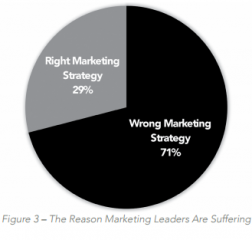Check any marketing textbook and it will tell you that a strategy is a carefully developed plan or method for achieving a goal. To me, it’s no comfort really that in most situations there can be multiple strategies to achieve the same goal. This may be due to legitimate causes – like maybe the degree of emphasis placed on economic and competitive issues, perhaps previous learning, possibly available budget, basically any of a host of factors peculiar to a particular situation or organizations. On the other hand, using different strategies to reach the same goal is a painful reminder that most strategies are almost tailor-made to fail. And they do fail at at an astonishing rate – according to SBI, 71% of marketers say the reason they struggle is that they have the wrong marketing strategy in place.
How can you avoid becoming a statistic?

Static Inputs Lead to Stale Results
Certainly data and the analytics you perform on it play a critical part in informing how any strategy is initially crafted and executed. Yet no matter how perfect our initial plan, over just a short time, the data points embedded in it are bound to have evolved. The reason for this is pretty obvious, yes? It’s because prospects and customers reactions to your strategy probably represent critical new information that should be accounted for and adjusted to. And of course, how we respond to these inputs (or don’t) could well make the difference between realizing the progress we seek with them or continuing blindly on our way as if the audience didn’t really exist at all.
That’s why I believe that in today’s world, where customer experience rules, any truly great strategy cannot be static. In fact, in today’s world, strategy is a process, a process of continuous refinement.
Why is it So Hard to Get Out of Our Own Way?
There are a pretty big set of challenges to implementing strategy as a continuous process. Here are two that stand out in my mind:
- There’s real pressure on us to publish plans and get them funded well in advance. Once a plan is “baked”, for many organizations like those I’ve worked in, that means we’re locked in. If we’re pretty good, we might re-examine things at the end of the quarter. With some luck, we might be supported in a decision to make a few modifications to the plan for the new quarter we’re now in.
- Another problem is that our complicated processes and old-fashioned organization models make certain that we’ll spend far too much time waiting for results and preparing reports on them for various interested parties. Our data processes are slow and our managerial processes slower still.
We’re Still Building Dis-Integrated Customer Experiences
No matter how “integrated” we may position our plan at the outset, the fact is that, in execution, that integrated marketing strategy soon becomes disintegrated. And if we’re to be honest with ourselves, the ‘customer experience’ (and therefore our results) suffer.
The fact is that we are not yet built to deliver true integration. Which means that we are not built to deliver good customer experience. While we’re heads-down launching tactics in line with our strategy, prospects and customers are doing what they need to do to solve their business problems. They’re combing the Web for information; listening to webinars; attending events; talking to peers, etc. No matter how many touches we have planned, simultaneous to our actions (and especially during the gaps between them), our target audience is changing right in front of us. We know this, but there’s little we are able to do about it if we keep on our current path.
A Better Way Forward
What if there was a better way? What if there was a way to renovate the process without having to rebuild your entire organization?
If…
- You agree that a better strategy for today’s world is one that’s more able to flex to market dynamics.
- You agree that your results are likely to improve if you can evolve your actions quickly based on real insight derived from real prospect and customer activities.
- You believe that knowing what’s going on more quickly could give you a much better chance at delivering better experiences.
Then…
- We think that true purchase intent data may be something very important to look into.
It’s Time to Fill Your Gaps
You need a better way to know what’s going on in the gaps between when you made your plan and how the market is responding to it. We think what’s going on in the gaps between each touch you execute (to any particular set of targets selected at periods’s outset) cannot help but have a significant impact on how you’ll perform over that timeframe and beyond.
We think there’s ample evidence already to suggest that proven purchase intent data, from a source you can easily understand right now, could well provide you a faster path to the kind of better experience you’re likely to already be pursuing in other channels. If you think this might be something you should investigate, we would like to hear from you – please feel free to leave a comment below or reach out to us here.
John Steinert is the CMO of TechTarget where unique purchase intent data solutions are powering the marketing approaches of 100s of technology vendors to the audiences they serve.




